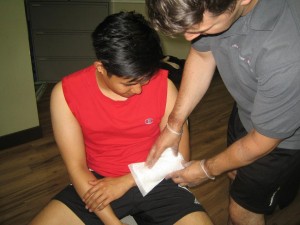Most cases of second degree burns can be treated at home to promote the healing process as well as prevent other complications. It is important that you are familiar on how to take care of this type of burn to prevent further damage. All you have to do is to register in a first aid class.
http://youtu.be/Dsvtzwp4nG8
Rinsing the affected area
Initially, the burned area must be rinsed under cool water until the pain stops. Take note that rinsing for 15-30 minutes will stop the pain. The cool water helps lower down the skin temperature as well as stopping the burn from getting serious.
- With a basin of cool water, immerse the affected hands, arms, fingers, legs, toes or feet.
- Apply a cool compress over the burns on the body or face.
- Do not use ice water or ice since it can cause damage to the tissue.
- Clothing and jewelry that is in the way or can become too tight if the skin swells must be taken off.
Cleaning the burn

The next step is to clean the burn thoroughly so that dirt and other debris are flushed away.
First, always wash your hands before cleaning any burn. Do not touch the burned area with your hand or anything dirty since it can become infected especially if there are open blisters. As much as possible, do not break open the blisters.
With mild soap and water, clean the affected area. Take note that some of the skin that has been burned might be washed away. After washing, pat the area dry using a clean gauze or cloth. Apply an antibiotic ointment after the burn has been cleaned. Do not apply butter or other oily substances on the wound since it will only trap heat inside the burn.
Applying bandage on the burn
In case the burned area or blisters have not opened, a bandage is required. In case the affected skin or unbroken blisters becomes dirty or becomes irritated by exposure to clothing, you have to place a bandage.
If the affected area or blisters are open, a bandage is needed. Infection can be prevented by applying a clean bandage once the previous bandage is soiled or wet. In case the bandage is stuck to the burn, you have to soak it in warm water so that it is easier to remove. If available, you can utilize a non-stick dressing; just make sure that you will read the label on how to use it properly.
When wrapping the burn, it must be loose in order to avoid putting pressure on the burned skin. Avoid taping a bandage that circles a hand, arm or leg since this can cause swelling. If the burn is on an arm or leg, the affected limb must be elevated if possible for the initial 24-48 hours to minimize the swelling. Additionally, the affected limb must be moved normally in order to keep the burned skin from healing too tightly which can limit the movement.
